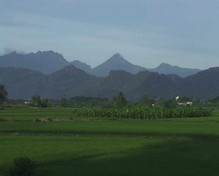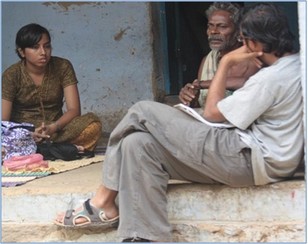Agasthya
A newsletter on the Natural History, Ecology
and Conservation of the Agasthyamalai region, Western Ghats, India.
ASHOKA TRUST FOR RESEARCH IN ECOLOGY AND THE ENVIRONMENT
Centre for Excellence in Conservation Science
Royal Enclave,Srirampura,Jakkur Post
Bangalore-560064
Telephone: 080-23635555 (EPABX)
Fax : 080- 23530070
Any and all opinions expressed in this newsletter are solely those of the author(s) and do not reflect the opinion of ATREE.
Editorial Team
Editor: T. Ganesh
Associate editor: Vivek Ramachandran
Editorial Review: R. Ganesan, M. Soubadra Devy
Design and presentation: Vivek Ramachandran
A S H O K A T R U S T F O R R E S E A R C H I N E C O L O G Y A N D T H E E N V I R O N M E N T
Farming practices by Kani tribes in the Mundanthurai plateau - sustainable ?
- Aparna Kolekar and Pradeep Kuttuva
Interviewing a Kani elder.
Photo: Sahana
The Kani tribas in the KMTR region, have been settled agriculturists, for quite some time. Apart from sustenance through the sale of crops they derive their income from sale of forest produce and other sources such as working as guides, and temporary jobs with the forest department. Some of the tribes have also been mainstreamed.
The objective of the study was to understand the natural farming methods practiced by the Kani tribes like multi-mixed cropping, organic cultivation, shifting cultivation, their different sources of income, information on their increased dependence on the external world because of changing food habits, like rice consumption, medicine etc. Another suite of qualitative questions addressed were their tolerance to crop loss due to wild animal, and their spiritual, emotional and cultural connection to the forest, village maintenance, and house construction etc.. so as to assess level of attachment with the forests. A sustainability index was then calculated based on the data obtained from the study, with a summation for positive indices like traditional crops, and negation for cash crops etc.
The data was collected was based on a questionnaire survey. Twenty individuals, from four different Kani settlements, with varying degrees of income, age, and occupation were informally interviewed, over a period of four days.
The preliminary results of the study indicated that the majority of the community led a sustainable life style, with values tending from -1.6 to 7.4, with a mode of 2 to 3. The trend was, however, on the negative side, with people moving towards an exploitative life style, with diminishing traditional food habits and medicine. If the traditional methods of agriculture, with less dependence on cash crops is maintained with a minimal external income from other sources, a more sustainable development model, can be formulated for the people in the reserve.








